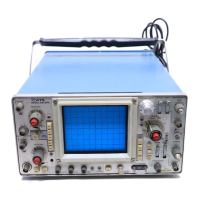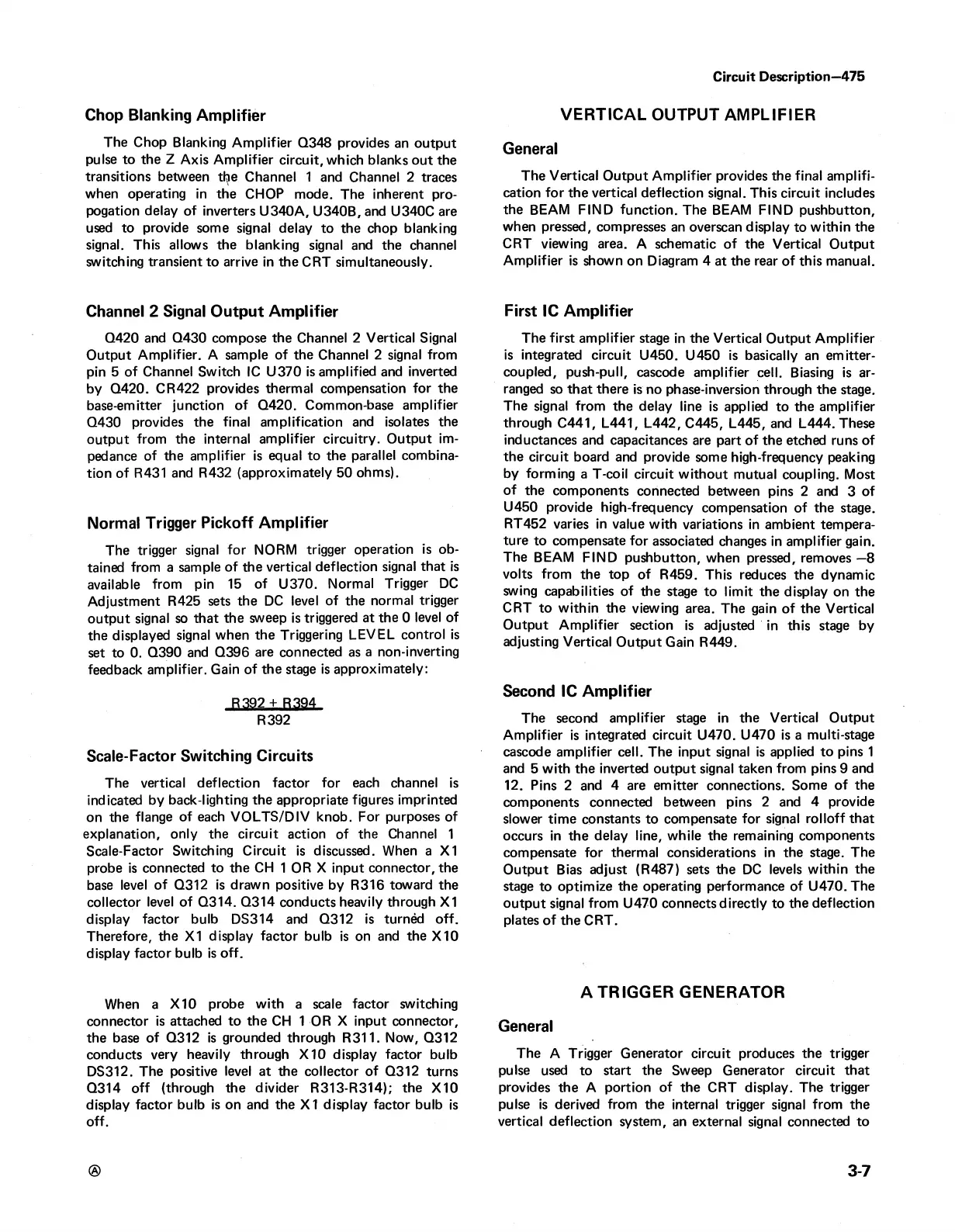Circuit Description—475
Chop Blanking Amplifier
The Chop Blanking Amplifier Q348 provides an output
pulse to the Z Axis Amplifier circuit, which blanks out the
transitions between the Channel 1 and Channel 2 traces
when operating in the CHOP mode. The inherent pro-
pogation delay of inverters U340A, U340B, and U340C are
used to provide some signal delay to the chop blanking
signal. This allows the blanking signal and the channel
switching transient to arrive in the CRT simultaneously.
Channel 2 Signal Output Amplifier
Q420 and Q430 compose the Channel 2 Vertical Signal
Output Amplifier. A sample of the Channel 2 signal from
pin 5 of Channel Switch 1C U370 is amplified and inverted
by Q420. CR422 provides thermal compensation for the
base-emitter junction of Q420. Common-base amplifier
Q430 provides the final amplification and isolates the
output from the internal amplifier circuitry. Output im
pedance of the amplifier is equal to the parallel combina
tion of R431 and R432 (approximately 50 ohms).
Normal Trigger Pickoff Amplifier
The trigger signal for NORM trigger operation is ob
tained from a sample of the vertical deflection signal that is
available from pin 15 of U370. Normal Trigger DC
Adjustment R425 sets the DC level of the normal trigger
output signal so that the sweep is triggered at the 0 level of
the displayed signal when the Triggering LEVEL control is
set to 0. Q390 and Q396 are connected as a non-inverting
feedback amplifier. Gain of the stage is approximately:
■fl»2,+,R3ai-
R392
Scale-Factor Switching Circuits
The vertical deflection factor for each channel is
indicated by back-lighting the appropriate figures imprinted
on the flange of each VOLTS/DIV knob. For purposes of
explanation, only the circuit action of the Channel 1
Scale-Factor Switching Circuit is discussed. When a X I
probe is connected to the CH 1 OR X input connector, the
base level of Q312 is drawn positive by R316 toward the
collector level of Q314. Q314 conducts heavily through X I
display factor bulb DS314 and Q312 is turned off.
Therefore, the X I display factor bulb is on and the X10
display factor bulb is off.
When a X10 probe with a scale factor switching
connector is attached to the CH 1 OR X input connector,
the base of Q312 is grounded through R311. Now, Q312
conducts very heavily through X10 display factor bulb
DS312. The positive level at the collector of Q312 turns
Q314 off (through the divider R313-R314); the X10
display factor bulb is on and the X I display factor bulb is
off.
VERTICAL OUTPUT AMPLIFIER
General
The Vertical Output Amplifier provides the final amplifi
cation for the vertical deflection signal. This circuit includes
the BEAM FIND function. The BEAM FIND pushbutton,
when pressed, compresses an overscan display to within the
CRT viewing area. A schematic of the Vertical Output
Amplifier is shown on Diagram 4 at the rear of this manual.
First 1C Amplifier
The first amplifier stage in the Vertical Output Amplifier
is integrated circuit U450. U450 is basically an emitter-
coupled, push-pull, cascode amplifier cell. Biasing is ar
ranged so that there is no phase-inversion through the stage.
The signal from the delay line is applied to the amplifier
through C441, L441, L442, C445, L445, and L444. These
inductances and capacitances are part of the etched runs of
the circuit board and provide some high-frequency peaking
by forming a T-coil circuit without mutual coupling. Most
of the components connected between pins 2 and 3 of
U450 provide high-frequency compensation of the stage.
RT452 varies in value with variations in ambient tempera
ture to compensate for associated changes in amplifier gain.
The BEAM FIND pushbutton, when pressed, removes —8
volts from the top of R459. This reduces the dynamic
swing capabilities of the stage to limit the display on the
CRT to within the viewing area. The gain of the Vertical
Output Amplifier section is adjusted in this stage by
adjusting Vertical Output Gain R449.
Second 1C Amplifier
The second amplifier stage in the Vertical Output
Amplifier is integrated circuit U470. U470 is a multi-stage
cascode amplifier cell. The input signal is applied to pins 1
and 5 with the inverted output signal taken from pins 9 and
12. Pins 2 and 4 are emitter connections. Some of the
components connected between pins 2 and 4 provide
slower time constants to compensate for signal rolloff that
occurs in the delay line, while the remaining components
compensate for thermal considerations in the stage. The
Output Bias adjust (R487) sets the DC levels within the
stage to optimize the operating performance of U470.The
output signal from U470 connects directly to the deflection
plates of the CRT.
A TRIGGER GENERATOR
General
The A Trigger Generator circuit produces the trigger
pulse used to start the Sweep Generator circuit that
provides the A portion of the CRT display. The trigger
pulse is derived from the internal trigger signal from the
vertical deflection system, an external signal connected to
3-7

